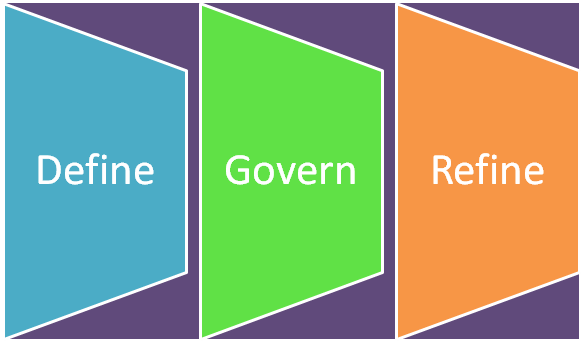
The corporate world turned to the use of contractors in order to bridge the skill gap when it came to needing personnel for ‘non-core’ ‘short duration’ activities which did not merit investment in nurturing permanent careers. Today contractors are a key part of the work force and represent scalable and often dispensable personnel to overcome a peak in demand or a need for niche services which are scarce or do not constitute the main focus of a company’s strategic objectives.
Managing contractors and enforcing SLAs is an integral part of the deliverables in a typical leadership role today. It follows three stages viz:
- DEFINE
- EXECUTE / GOVERN
- REFINE
Most often we inherit existing contracts and personnel as well as pre-defined SLAs. This forces the Execute/Govern phase on us without the benefit of having the Define phase to start with.
Let us examine the phases and document key success factors in deriving best value from a portfolio of contract services.
Initially, based on organizational objectives, sponsorship is first obtained to engage professional contractors to execute business operation tasks to achieve pre-defined outcomes. With due competitive bidding a set of qualified contractors are assigned the task and a formal documentation is put in place to serve as the baseline.
The Define Phase
Obtain a clear definition of the scope and document the expected outcomes.
Obtain stakeholder confirmation of this understanding and publish widely within the organization.
Keep the RFI / RFP & selection process transparent and encourage stakeholder / delegate participation.
Once selected, induct the contractor into the business landscape and provide enough visibility to the key stakeholders as well as the impacted community.
The Execute/Govern Phase
Measuring & reporting are key operational actions both of which require reliable data and a consistent baseline. Defining these using industry standard templates is the appropriate starting point of the execution journey in order to ensure good governance.
Creating a wireframe for stakeholders will enable them to follow a simplified approach to oversight and the use of standard templates will ensure that all relevant aspects are addressed
Stakeholders must be coached on defined SLAs, expected outcomes, penalty clauses and at the same time, must be provided suitable baseline data to appreciate ongoing achievement of results.
Ensure that the governance forum represents stakeholders and regulators / compliance interests in order to adequately cover audit related aspects upfront
Publish and adhere to a regular governance timetable as well as enforce operational level meetings with documentation of issues and resolution items ideally available on the intranet for transparency.
Obtain regular feedback by way of survey results and incorporate this data into the governance process in order to illustrate trends and effectively manage course correction.
The Refine Phase
Remember! Data is everything and trends tell an eloquent story.
Enforce regular measurements of performance against pre-defined SLAs. Baseline data built over several execution cycles as the contract execution progresses will yield rich trend data for the refine phase.
Stakeholders require a refresh of the scope and objectives especially in the case of contracts with a long tenure. Changes in the business environment, competitive and regulatory pressures as well as cost considerations dictate such periodic reviews. This should be an integral part of the governance process itself,
Such introspection is the best catalyst for ‘refining’ contract outcomes and can often result in tweaking pre-agreed SLAs, defining additional outcome indicators and imposing new bonus-malus criteria to fine tune contractual outcomes.
Ideally a stage-wise review with pre-agreed milestones for ‘tweaking’ contractual clauses should be baked into the original documentation with an allowance for margin so that neither party in unfairly disadvantaged,
A summary of mutually agreed contract amendments especially to defined SLAs must be documented and formally approved thorough the governance process.
This may then call for re-base lining performance criteria as well as SLAs from the defined stage milestone.
In summary, contract management covers the aspects of procuring contractual services for achieving pre-defined reliable and consistent outcomes in various business operations with an ability to illustrate to stake holders the adherence to industry standards, transparent matrices and measurable outcomes.
In order to remain effective the process must provide for robust governance and quick recognition of trends as well as the ability to refine and revise the results across the cross section of business processes within the contract remit.
The author is part of the leadership team of a reputed consulting firm

 In
In
Add new comment